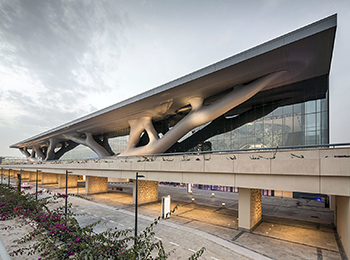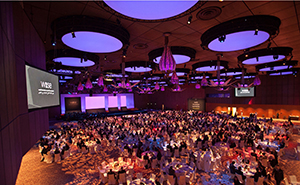Qatar’s Green Convention Center Sets the Bar in Middle East
 DOHA, Qatar — It’s hard to miss. With 880,000 square feet, the Qatar National Convention Centre (QNCC) is the largest convention center in the Middle East. In its first year, the facility hosted 212 events and welcomed more than 150,000 visitors and delegates.
DOHA, Qatar — It’s hard to miss. With 880,000 square feet, the Qatar National Convention Centre (QNCC) is the largest convention center in the Middle East. In its first year, the facility hosted 212 events and welcomed more than 150,000 visitors and delegates.
The facility is making news again for its commitments to sustainable design and operations. This May, the World Travel Awards, known as the “The Oscars” of the travel industry, for the second time in two years named the center the Middle East’s Leading Exhibition & Convention Centre 2014.
Completed in 2009, the six-story structure is located on the campus of Education City in Doha, Qatar, and is surrounded by six U.S. university campuses, including Weill Cornell, Texas A&M, Carnegie Mellon and Georgetown. The center features 10 lecture halls, a 2,400-seat performing arts theatre, a 500-seat concert hall, an exhibition hall and banquet facilities for up to 10,000 occupants collectively.
Built according to U.S. Green Building Council’s LEED Gold standards, the QNCC design by YAMASAKI was based on the initial concept of architect Arata Isozaki of Japan. The prominent sculptural façade, which is about 750 feet long and five stories tall (and also changes color), symbolizes the native Sidra tree. The steel limbs of the tree help support the 120-foot-long by 90-foot-wide concrete roof.
It’s as symbolic as it is beautiful. The tree represents the country’s heritage, and for generations, the tree has been a symbol of comfort and strength in the harsh desert environment, sprouting fruits, flowers and leaves that nourish and heal. The tree also provides shelter to travelers and scholars who gather together under its shade to share knowledge.
 The striking tree is also the logo for the Qatar Foundation, a nonprofit that contributed an estimated $1.2 billion to construct the enormous convention center. Developed in 1995, the foundation helps develop people’s abilities through investments in human capital, innovative technology, strategic partnerships and state-of-the-art facilities.
The striking tree is also the logo for the Qatar Foundation, a nonprofit that contributed an estimated $1.2 billion to construct the enormous convention center. Developed in 1995, the foundation helps develop people’s abilities through investments in human capital, innovative technology, strategic partnerships and state-of-the-art facilities.
As part of its energy-efficient design, QNCC has solar panels installed on the roof area, which contribute 12.5 percent of the building’s total electrical consumption. Other green features include water-efficient fixtures, occupancy sensors, carbon dioxide monitors, LED lighting and sustainable air-volume systems. The convention center was the first of its type in the region to be built to LEED-certification standards. According to the QNCC website, the convention center is approximately 32 percent more efficient compared with a similarly designed building without such innovations.
“QNCC is an integral part of Qatar Foundation’s mission to achieve one of the most dynamic, knowledge-based economies in the world by offering our first-class venue as a hub for international conferences and events,” said Adam Mather-Brown, general manager of QNCC, when the center was first opened. “We are supporting Qatar Foundation in its journey to enhance education, science and technology, and community development, and our facilities and venue are a catalyst for the delivery of that vision.”
Best known for its design of the World Trade Center in New York City, YAMASAKI has been providing international planning, architecture, engineering and project management since 1955.
